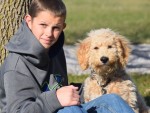This was a great article I read from Life’s Abundance website. This is where we purchase our dog food for our Australian Labradoodles. It is a great product and they write great articles. This article was published on June 15, 2016. We have also published other articles on dog communication, click here to read more. Enjoy!
Dog Do Communicate
The first time he came to our house, my son’s friend Joey announced he hated dogs.
Given that we have a dog – and a cute one at that, a goofy Golden who loves any and all people – this is a bit of a problem. Joey was nonetheless fearful, so I had my dog in the yard for a bit. When I asked Joey why he hates dogs, he said it was because every dog he had ever met, starting with his own min pin when he was younger, bit him.
Joey was nonetheless fearful, so I had my dog in the yard for a bit. When I asked Joey why he hates dogs, he said it was because every dog he had ever met, starting with his own min pin when he was younger, bit him.
To be fair, if every dog I met bit me I might be nervous around them as well. But it’s indicative of a much bigger problem.
Joey is not a rare case. In the United States, 900,000 people a year require medical attention due to a non-fatal dog bite; half of them are children, whose small stature and lack of inhibition make them more prone to these sorts of incidences. We all hear about the tragic cases in the news of dogs killing people who were minding their own business, and it is horrifying and heartbreaking. But it is also, thankfully, rare. The vast majority of these bites are preventable.
My fellow veterinarians like to joke that we have a harder job than MDs because our patients can’t talk, but that’s not entirely true. Dogs may not speak our language, but they sure as heck communicate. It’s just that we aren’t listening properly.
If you want a perfect example of what a distressed dog looks like, just hit up your local veterinary clinic. All those picture memes of dogs going to the vet are a perfect list of all the things dogs do to broadcast when they are feeling uncomfortable …
• Hiding behind their owners
• Shaking
• Lip licking
• Yawning
• Tail tucked
• “Half moon” of the eye showing
• Turning away from you
And take growling, for example: how many times have you seen a dog get scolded for growling? We should be rewarding them! This is them shouting, loud and clear: “I am really unhappy right now. Whatever is going on here, please stop. Don’t make me escalate things.” It’s scary when you see it, especially when a dog is growling at a young child, but it is an immediate signal for you to intervene and make the situation safe.
Some signs are more subtle than others, and can be easy to miss if you don’t know how to look for them. It is extremely rare for a dog to jump right into bite mode without giving at least one or two of these signs ahead of time. We just don’t recognize it.
Time and time again, I see people – often kids – go right up to a dog exhibiting these behaviors and start patting them and talking to them. Do you remember when women in department stores used to walk up and spray you with perfume without asking first? They stopped because too many people were snapping at them. It’s kind of like that.
I imagine most people on the Life’s Abundance site know a lot more than the average bear about doggie body language, and if you have kids they probably do as well. From the time my kiddos were toddlers, we worked (and worked and worked, because it takes time) to teach them about respecting animals’ space. In some respects, kids comfortable with the family dog are even more at risk for bites, because they are used to approaching dogs who are very comfortable with being handled and may be overly familiar with strange dogs.
So we practice, and just as importantly, we make other kids practice with us too. When my dog is showing classic relaxed body posture (wiggling, leaning into people for pets), I take this as an opportunity to show kids who may have never been taught how to approach a strange dog …
1. Use your EYES to see if the dog wants to be approached
2. Use your MOUTH to ask for permission
3. Use your HAND to hold it out and let the dog approach you
4. Only then can you pat the dog, gently, on its side … not its face!
So many times when a dog bites, the owner says, “We never saw it coming!” That doesn’t mean the signs weren’t there. I’d encourage every pet parent out there to make it part of their daily life to teach those they encounter about how to approach a dog. You just might save them some trauma down the line.
As for Joey? Over time, he began to feel empowered as he understood how to evaluate dogs and when to walk away. The last time he came over, he asked to take Brody for a walk. It doesn’t take much to keep people dog safe, just a little time and effort. Are you in?

Click To Enlarge
Photo by lili.chin / CC BY

Click To Enlarge
Photo by lili.chin / CC BY
 Dr. Jessica Vogelsang
Dr. Jessica Vogelsang
Dr. Jessica Vogelsang is a graduate of the prestigious UC Davis School of Veterinary Medicine with experience in both emergency and general practice. Quickly recognized as an entertaining and informative voice in the pet world, Dr. V is one of the most widely read veterinarians on the web and has become a much sought-after contributor in print, television and radio. Not only that, but Dr. V is one of a small group of veterinary and journalism experts to have earned the title of Certified Veterinary Journalist through the American Society of Veterinary Journalists. Dr. V is currently featured in the series “Animals Gone Wild” on Nat Geo Wild on Friday nights at 9:00 p.m. Eastern Time.
Cheryl Sabens
Ashford Manor Labradoodles
Indiana Australian Labradoodle Breeder
765-714-1436

Recent Comments